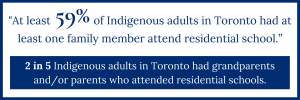Private: Education
Current Implications to Indigenous Education
As residential schools were shuttered, ending in 1996, Indigenous children were assimilated into Canadian schools governed by district school boards and based on Eurocentric educational systems. Until recently, these school boards did not acknowledge or include Indigenous history or ways of teaching, perpetuating these losses for Indigenous children.
Although day and residential schools no longer exist, their impacts continue to haunt children who attended and subsequent generations currently living in and outside Toronto. Our Health Counts, an Indigenous-led initiative, has published valuable primary research on the ongoing impacts of residential schools on Toronto’s Indigenous populations, citing that “At least 59% of Indigenous adults in Toronto had at least one family member attend residential school” (p. 1).

Indigenous teaching is much more tightly connected to the community than the education supported by the rest of the Canadian school system. Education should support one’s way of being part of the community and contributing to that community in a meaningful way as one matures. As educator Sir Kenneth Robinson suggests in his criticism of educational systems, the contemporary school system most students in Canada have grown up with kills creativity and innovative thinking.
Indigenous educators have established schools that exist within both the Indigenous community and the Toronto District School Board. One example is the Kapapamahchakwew or Wandering Spirit School, started in 1977, offering a holistic, child-centred, culturally relevant education for Indigenous children from JK to grade 12. The school has since been renamed the First Nations School of Toronto. Building on an Indigenous educational model, this school offers intergenerational education and includes community, cultural, language, and childcare supports. This integrated approach helps students recognize multifaceted Indigenous perspectives and integrate into their own Indigenous communities through a decolonizing educational lens. Ceremony is used as an educational tool led by the teachings of Elders and other traditional knowledge keepers.
The First Nations University in Regina, Saskatchewan offers post-secondary Indigenous education to students across Canada, as well as housing digital resources for the National Centre for Collaboration in Indigenous Education (NCCIE). This valuable resource offers a wealth of information for research, education, and community building. The Ontario Student Assistance Program (OSAP) offers Indigenous Student Bursaries, as well as Indigenous Travel Grants for students attending universities far from their homes. Additional awards and scholarships are available through the First Nations Caring Society, as well as Indspire.

